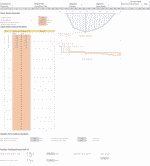Equialent UDL from Point Loads in Beam

Description
Calculating the equivalent distributed load from a set of point loads in a beam can be highly beneficial to an engineer for several reasons:
-
Simplified Analysis: Converting multiple point loads into an equivalent distributed load simplifies the analysis of the beam. Instead of dealing with individual loads, engineers can analyze the beam under a single uniform load, which reduces complexity and makes calculations more manageable.
-
Efficiency: Handling a single distributed load streamlines the structural analysis process, saving time and effort for engineers. It allows for quicker evaluations of beam behavior and facilitates the design process.
-
Visualization: A distributed load is easier to visualize and interpret compared to multiple discrete point loads. Engineers can better understand how the load is distributed along the length of the beam, which aids in assessing the structural response and identifying critical regions.
-
Uniform Loading Assumption: In many engineering applications, it is common to assume uniform loading for simplicity. By converting point loads into an equivalent distributed load, engineers can apply this simplifying assumption while still capturing the overall effect of the original loads on the beam.
-
Conservative Design: In some cases, converting point loads into an equivalent distributed load may result in a conservative estimate of beam behavior. This ensures that the beam is adequately designed to withstand the actual loading conditions, reducing the risk of structural failure.
-
Compatibility: The use of equivalent distributed loads facilitates compatibility with various structural analysis methods and software tools. Many analysis techniques, such as finite element analysis, work more effectively with distributed loads than with discrete point loads.
-
Design Optimization: Simplifying the load distribution allows engineers to explore different design options and optimize beam dimensions more efficiently. They can easily adjust the magnitude and distribution of the equivalent load to assess the impact on beam performance and identify the most effective design solution.
Overall, calculating the equivalent distributed load from a set of point loads enables engineers to analyze beams more efficiently, make informed design decisions, and ensure the structural integrity and safety of the overall system.
Calculation Preview
Full download access to any calculation is available to users with a paid or awarded subscription (XLC Pro).
Subscriptions are free to contributors to the site, alternatively they can be purchased.
Click here for information on subscriptions.


